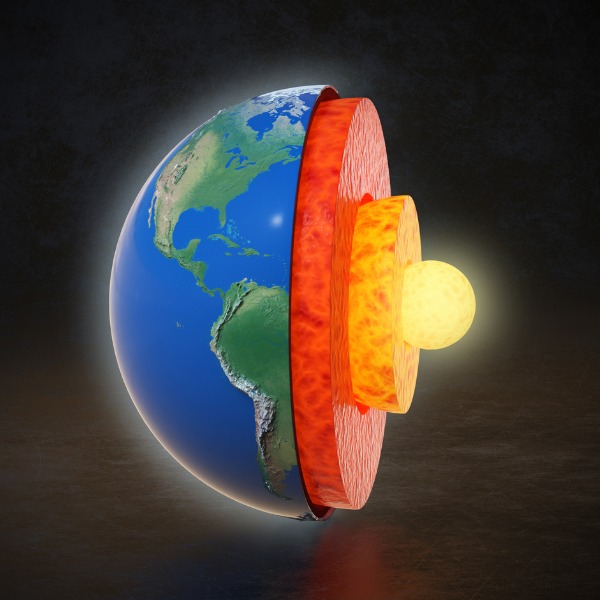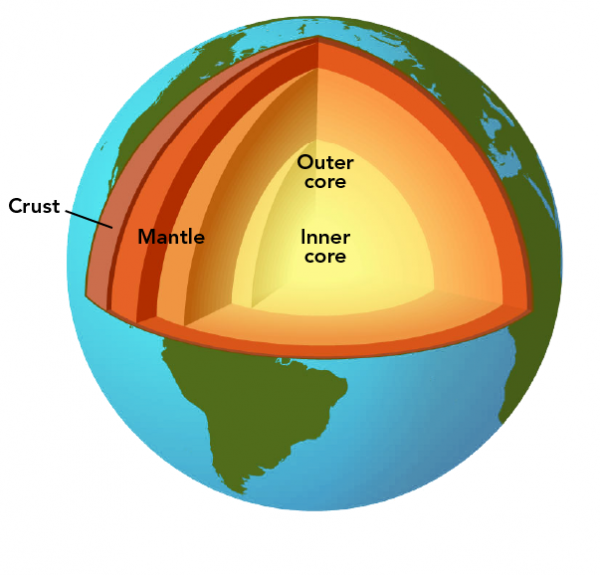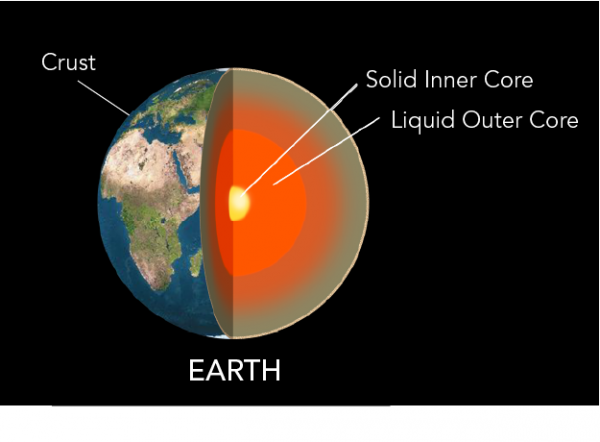Why does the Earth have Layers?

Cross-section of the Earth showing layers (koya79, istockphoto)

Cross-section of the Earth showing layers (koya79, istockphoto)
How does this align with my curriculum?
| Grade | Course | Topic |
|---|
An in-depth look at how the Earth got its layers.
You probably know that the Earth has layers. But do you know why? Let’s look at what happened on Earth and in space to form these layers.
What is density?
Everything in the universe is made up of molecules. In solids, the molecules are packed together very closely. They’re packed less closely together in liquids, and even less closely together in gases. That’s why liquids and gases can take the shape of the container they’re in, while solids cannot.
Density (D) is the relationship between the mass (m) of an object or substance and its volume (v). It can be calculated using the formula D = m/v. Consider wood and lead. Both are solids. But a cubic metre of lead has much more tightly packed molecules than a cubic metre of wood. That means a cubic metre of lead also has a greater mass than a cubic metre of wood. So for the same volume, lead will be much more dense than wood.
Denser objects and substances experience a greater gravitational force acting upon their mass. This is why materials of different densities form layers. Have you ever seen a salad dressing made of oil and vinegar? The oil is less dense than vinegar, so it forms a layer on top of the vinegar.
These concepts can also be applied to the Earth’s layers. The Earth’s atmosphere is made up of gases. It is less dense than the Earth’s crust, which is a solid. This is why the Earth’s surface and atmosphere form distinct layers.

Density will become important again in a minute. But first, we have to look at the materials that made up Earth in the first place.
How does the formation of planets affect their layers?
Before there were planets or stars in the universe, there were just a lot of hydrogen and helium atoms floating around. These atoms eventually formed clouds of gas that developed their own gravity. As the gravitational forces grew stronger and stronger, the stars were created. The process of nuclear fusion prevents the very dense cores of new stars from collapsing in on themselves. As nuclear fusion progresses, heavier elements form within the stars. Carbon, oxygen, nickel and iron are examples of these heavier elements.
Hydrogen and helium continued to form stars, such as the Sun. But the heavier elements began to collide, forming dust and debris. Eventually, this dust and debris formed various astronomical bodies. We know these bodies today as asteroids, moons, and planets.
In our solar system, planets closer to the Sun are different than planets further away. Mercury, Venus, Earth, and Mars are the four planets closest to the sun. They are rocky and dense, and are called the terrestrial planets. Jupiter, Saturn, Uranus, and Neptune are further away. They are often called the “gas giants.”
Why the difference? In the early days of our solar system, the Sun was still undergoing nuclear fusion. At this time, it emitted a powerful solar wind. Scientists think this solar wind stripped away most of the gaseous atmosphere surrounding the terrestrial planets.
But let’s get back to Earth. Roughly 4.5 billion years ago, the gases that made up the young Earth began to condense into a solid rocky mass of elements. Earth was shaped by the effects of gravity, radioactivity, and physical disturbances like meteorite bombardment and volcanic activity. Around 3.8 billion years ago, the Earth’s mantle began to cool. An atmosphere containing oxygen began to form. And because it contained oxygen, it could sustain life.
How does density determine what is found in each layer?
Now, let’s get back to density. Before the elements within the Earth began to cool and form layers, their densities determined where they would go. Denser materials, like iron and nickel, sank to the core. Lighter materials, like aluminum and silicon, stayed closer to the Earth’s surface. The process in which the chemical elements separated by density is called planetary differentiation.
Did you know?
The iron in the Earth’s core is estimated to be about 6 000 degrees Celsius. That’s as hot as the surface of the Sun!
How do scientists know what it is like inside the Earth?
Scientists believe that the Earth’s inner core is solid, while its outer core is liquid. That’s because the inner core is under a lot more pressure than the outer core.

Wait. How do scientists know this? Have they actually travelled to the Earth’s inner core?
No, they have not. Instead, scientists actually get all kinds of clues about the Earth’s layers from seismic activity. In other words, earthquakes tell scientists a lot about what’s going on under the surface. Seismic activity is a way for scientists to understand the Earth’s layers without having to find a way to actually dig down and examine them!
Seismic waves are waves of energy caused by the sudden breaking of rock within the Earth, such as during an earthquake. As seismic waves travel through the Earth’s core, the liquid does one of two things. It may refract the seismic waves, or change their direction. Or, it may altogether block the seismic waves. Blocked seismic waves create a seismic shadow zone on the opposite side of the Earth. Scientists have used this knowledge about blocked seismic waves to determine that the Earth’s core is liquid. This is because some types of seismic waves can only travel through solid materials. So if they’re blocked by something at the centre of the Earth, it means that the core is actually liquid!
But in the 1930s, Inge Lehmann further improved that model. She was studying the faint seismic waves detected within the shadow zone that other scientists thought were caused by faulty instruments.By using her mathematical and physics knowledge, she created the model we now know today that puts a solid core at the center of the Earth.
The creation of Earth’s layers is a complex process, and for many years it was little understood. Thanks to the hard work of scientists studying the Earth and its layers, we learn a bit more about what’s really going on under our feet every day!
Starting Points
- Would you like to have a job that studies the layers of the Earth? Why/why not?
- What is the deepest you have been into the Earth?
- Predicting events related to the Earth’s structure, like volcanic eruptions and earthquakes, is very difficult. Why do you think this is?
- How important is continued research into Earth’s internal structure? Explain.
- The nebular hypothesis is an explanation of how our solar system formed. Briefly explain this concept and how it led to planet formation.
- Explain how density led to planetary differentiation and the formation of Earth.
- What are the layers of the Earth (from inside to outside)?
- How do scientists use seismic activity to study the Earth’s interior?
- Earth is quite large and as a result, it is very difficult to access areas below the crust. How has technology helped us to “see” beyond this physical limitation? Explain.
- The evidence that our planet consists of layers comes from our understanding of density. Explain how this is an example of how scientific understanding is built on our previous knowledge.
- Using online resources, research technologies that have enhanced our knowledge of Earth’s interior during the last 100 years.
- The movie The Core illustrates Earth’s interior from crust to core. It portrays an attempt to reach the inner core to fix our magnetic field. Do you think such a venture may be possible in our future? Why or why not?
- Do movies like The Core create unrealistic expectations of what science and scientists can do? Explain.
- This article supports teaching and learning of Earth and Space Science related to the Earth’s interior and the formation of our Solar System. Concepts introduced include density, mass, volume, D=mv, crust, solar system, terrestrial planets, gas giants, mantle, core, planetary differentiation, refract and seismic activity (seismic waves, seismic shadow zone).
- Before reading this article, have students use the Vocabulary Preview Learning Strategy. Download ready-to-use reproducibles using the Vocabulary Preview Learning Strategy for this article in [Google doc] and [PDF] formats.
- To consolidate understanding of the concept of Earth’s layers, teachers could have students complete a Concept Definition Web learning strategy. Download ready-to-use reproducibles using the Concept Definition Web Learning Strategy for this article in [Google doc] and [PDF] formats.
Connecting and Relating
- Would you like to have a job that studies the layers of the Earth? Why/why not?
- What is the deepest you have been into the Earth?
Relating Science and Technology to Society and the Environment
- Predicting events related to the Earth’s structure, like volcanic eruptions and earthquakes, is very difficult. Why do you think this is?
- How important is continued research into Earth’s internal structure? Explain.
Exploring Concepts
- The nebular hypothesis is an explanation of how our solar system formed. Briefly explain this concept and how it led to planet formation.
- Explain how density led to planetary differentiation and the formation of Earth.
- What are the layers of the Earth (from inside to outside)?
- How do scientists use seismic activity to study the Earth’s interior?
Nature of Science/Nature of Technology
- Earth is quite large and as a result, it is very difficult to access areas below the crust. How has technology helped us to “see” beyond this physical limitation? Explain.
- The evidence that our planet consists of layers comes from our understanding of density. Explain how this is an example of how scientific understanding is built on our previous knowledge.
- Using online resources, research technologies that have enhanced our knowledge of Earth’s interior during the last 100 years.
Media Literacy
- The movie The Core illustrates Earth’s interior from crust to core. It portrays an attempt to reach the inner core to fix our magnetic field. Do you think such a venture may be possible in our future? Why or why not?
- Do movies like The Core create unrealistic expectations of what science and scientists can do? Explain.
Teaching Suggestions
- This article supports teaching and learning of Earth and Space Science related to the Earth’s interior and the formation of our Solar System. Concepts introduced include density, mass, volume, D=mv, crust, solar system, terrestrial planets, gas giants, mantle, core, planetary differentiation, refract and seismic activity (seismic waves, seismic shadow zone).
- Before reading this article, have students use the Vocabulary Preview Learning Strategy. Download ready-to-use reproducibles using the Vocabulary Preview Learning Strategy for this article in [Google doc] and [PDF] formats.
- To consolidate understanding of the concept of Earth’s layers, teachers could have students complete a Concept Definition Web learning strategy. Download ready-to-use reproducibles using the Concept Definition Web Learning Strategy for this article in [Google doc] and [PDF] formats.
Learn more
Everything You Need to Know About Planet Earth (2014)
Kurzgesagt - In a Nutshell (7:21 min.) Video detailing the timeline of the history of Earth, its creation, and composition.
What is Density? Density Explained (2018)
This video (4:27 min.) by The Engineering Mindset explores density, why it’s important and how it’s calculated.
The Lifecycle of Stars (2012)
This video (4:58 min.) by Institute of Physics, illustrates how scientists believe nuclear fusion forms stars, including the Sun.
The Solar System: The Terrestrial Planets
This article from NASA Science explores the four innermost planets in the solar system.
Inge Lehmann: Discoverer of the Earth's Inner Core
This article from the American Museum of Natural History describes how seismologist Inge Lehmann studied seismic waves to discover the Earth’s solid inner core.
Ask Smithsonian: What’s the Deepest Hole Ever Dug? (2015)
This article, with video (1:17 min.), explains the Kola Superdeep Borehole and other experiments scientists and engineers have conducted to explore the Earth’s mantle.
References
Balzer, A. (2019, February 19). Why are the inner and outer planets so different? Owlcation.
Baraniuk, C. (2015, August 13). How we know what lies at Earth's core. BBC.
Jones, A. Z. (2018, October 25). An introduction to density: Definition and calculation. ThoughtCo.
Nagaraja, M. P. (2019, August 19). How do stars form and evolve? NASA.
Ophardt, C. E. (2013). What is density? Elmhurst College.
UPSeis. (2007). What is seismology? Michigan Technological University.
Williams, M. (2014, December 10). How was the Earth formed? Phys.org.